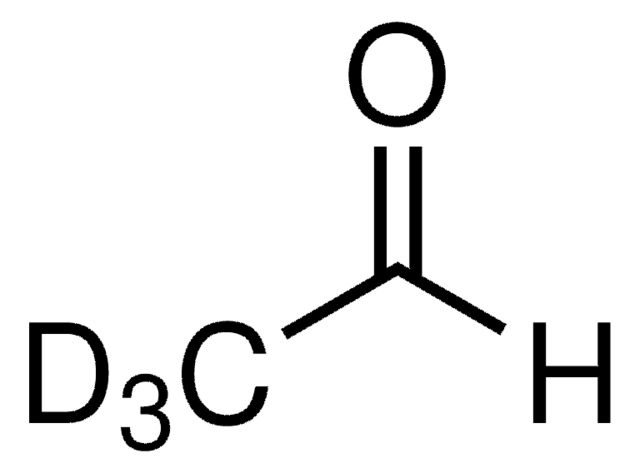00071
Acetaldehyd
ReagentPlus®, ≥99.0% (GC)
Synonym(e):
Ethanal
About This Item
Empfohlene Produkte
Biologische Quelle
synthetic
Qualitätsniveau
Dampfdichte
1.52 (vs air)
Dampfdruck
14.63 psi ( 20 °C)
Produktlinie
ReagentPlus®
Assay
≥99.0% (GC)
Form
liquid
Selbstzündungstemp.
365 °F
Expl.-Gr.
60 %
Brechungsindex
n20/D 1.332 (lit.)
bp
21 °C (lit.)
mp (Schmelzpunkt)
−125 °C (lit.)
Dichte
0.785 g/mL at 25 °C (lit.)
Lagertemp.
2-8°C
SMILES String
CC=O
InChI
1S/C2H4O/c1-2-3/h2H,1H3
InChIKey
IKHGUXGNUITLKF-UHFFFAOYSA-N
Suchen Sie nach ähnlichen Produkten? Aufrufen Leitfaden zum Produktvergleich
Verwandte Kategorien
Allgemeine Beschreibung
Anwendung
Vorsicht
Rechtliche Hinweise
Signalwort
Danger
Gefahreneinstufungen
Carc. 1B - Eye Irrit. 2 - Flam. Liq. 1 - Muta. 2 - STOT SE 3
Zielorgane
Respiratory system
Lagerklassenschlüssel
3 - Flammable liquids
WGK
WGK 3
Flammpunkt (°F)
-38.0 °F - closed cup
Flammpunkt (°C)
-38.89 °C - closed cup
Persönliche Schutzausrüstung
Eyeshields, Faceshields, Gloves
Zulassungslistungen
Zulassungslistungen werden hauptsächlich für chemische Produkte erstellt. Für nicht-chemische Produkte können hier nur begrenzte Angaben gemacht werden. Kein Eintrag bedeutet, dass keine der Komponenten gelistet ist. Es liegt in der Verantwortung des Benutzers, die sichere und legale Verwendung des Produkts zu gewährleisten.
EU REACH Annex XVII (Restriction List)
Choose from one of the most recent versions:
Analysenzertifikate (COA)
Don't see the Right Version?
If you require a particular version, you can look up a specific certificate by the Lot or Batch number.
Besitzen Sie dieses Produkt bereits?
In der Dokumentenbibliothek finden Sie die Dokumentation zu den Produkten, die Sie kürzlich erworben haben.
Kunden haben sich ebenfalls angesehen
Artikel
The aldol condensation reaction is an organic reaction introduced by Charles Wurtz, who first prepared the β-hydroxy aldehyde from acetaldehdye in 1872.
Unser Team von Wissenschaftlern verfügt über Erfahrung in allen Forschungsbereichen einschließlich Life Science, Materialwissenschaften, chemischer Synthese, Chromatographie, Analytik und vielen mehr..
Setzen Sie sich mit dem technischen Dienst in Verbindung.






